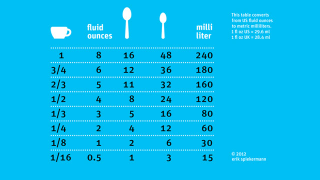
Where a volume measurement isn’t useful (e.g., for chocolate or some of the fresh produce), weight measurements are provided in both ounces and grams. Always check the book to see if this has been clearly mentioned.įor other ingredients where the measuring method affects the weight-such as cocoa powder, confectioners’ sugar, cornstarch, nut flours, matcha, baking powder, and spices-I have provided weight equivalents using the spoon-and-sweep method, where the ingredient is spooned into a measuring cup or spoon, then swept across the top with the back of a knife to level it. For flour, I provided weight equivalents using the scoop-and-sweep method (use a spoon to fluff up the flour in the bin, dip the measuring cup into the flour and scoop it up, then sweep across the top of the cup with the back of a knife to level it), but the author of the book you are baking from may have used the spoon-and-sweep method, which will give you a different amount. Weights can vary considerably depending on the method used to measure them. Measuring Methods for Different Ingredients
#60 TABLESPOONS TO CUPS FREE#
If you still like to proceed with using measuring cups and spoons or if you are cooking or baking from a cookbook that doesn’t include weights of ingredients, feel free to use the baking conversion charts below, but be aware of the fact that I’ve measured every ingredient below myself. For other baking equipment that I’ve tested over the years and recommend, take a look at my Essential Baking Tools & Equipment page. For a more budget-friendly option, consider Etekcity’s kitchen scale, currently priced at just $13.99 and ranked as the #1 best seller in kitchen scales on Amazon.įor greater precision when weighing spices, baking soda, etc., I use Weigh Grams’s Pocket Scale, which allows you to weigh a maximum capacity of 100 grams with 0.01 gram resolution (in order to keep it calibrated and accurate, I also recommend buying this calibration weight). My personal recommendation is the My Weigh KD8000 Multi-Purpose Digital Kitchen & Hobby Scale, with an impressive 8000 gram capacity and 1 gram resolution. Make sure the scale includes a tare function, which allows you to reset the scale to zero after placing a bowl or container, making it convenient for weighing multiple ingredients in the same container. Look for a model that easily toggles between ounces and grams, preferably offering decimals or both decimals and fractions, in increments as small as 1 gram. You’ll reap the benefits of consistent results, easier cleanup, and a more streamlined process. If you enjoy baking, investing in a digital scale is a game-changer.

Precision is paramount in baking, and measuring ingredients by weight (grams) will make you a better baker. You’ll also find an egg size conversion chart. If you have no idea how much that is, check our temperature converter to convert it into Fahrenheit, Kelvin, or any other temperature unit you want.The cooking and baking conversion charts on this page will help you convert measurements from cups to grams and ounces as well as convert recipes from yeast to sourdough or sourdough to yeast. Then, just make a dough and bake the shortcakes for 15-20 minutes in the oven heated to 190 ☌. For sugar, you've found out its around 2 oz, and also that you need 1.3 US cups of flour. Repeat the same steps for the other two ingredients. Here you are - the converter did the job! Now you know that 125 grams is a bit over one stick of butter (1.1), and it's equivalent to 0.55 of a cup.Use a drop-down list if the unit you're looking for is not visible. If your product is not on the list but you know the ingredient's density, just hit the Advanced mode button and change the density value. Let's start with the first product: butter. Unfortunately, the recipe is from across the pond, and the units look somewhat strange to you:īut you don't have to give up! Just use this cooking measurement converter: You've found some delicious-looking shortcakes. In some categories, you can even specify the type of the product. In our cooking measurement converter, we've chosen seventeen essential ingredients. In this kind of conversion, we cannot provide one general conversion table - it would differ for every ingredient!

So, to calculate how many grams are in a cup, you need to know if it's a cup of sugar, flour, or honey. For that, you need to know the ingredient and, more specifically - its density: And here, we come to the core of the calculator - conversion from weight units to volume or from volume to weight.


 0 kommentar(er)
0 kommentar(er)
